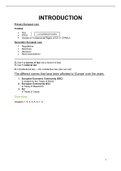INTRODUCTION
Primary European Law:
Treaties:
TEU
= consolidated treaties
TFEU
Charter of Fundamental Rights of EU (= CFREU)
Secundary European Law:
Regulations
Directives
Decisions
Recommendations
_______________________________________________________________
EU law = a source of law (not a branch of law)
EU law = national law
EU constitutional law ↔ EU substantive law (zien we niet)
The different names that have been afforded to ‘Europe’ over the years:
1. European Economic Community (EEC)
à created by the Treaty of Rome
2. European Community (EC)
à Treaty of Maastricht
3. EU
à Treaty of Lisbon
Overview
Chapters 1, 2, 3, 4, 5, 6, 7, 9
1
, CHAPTER 2: THE CREATION
OF A EUROPEAN UNION
2.1 THE FIRST TREATIES
Victor Hugo 1894
= French writer
“A day will come when all the nations of this continent, without losing their distinct qualities or
their glorious individuality, will fuse together in a higher unity and form of European
brotherhood.
A day will come when the only battlefield will be the marketplace for competing ideas.
A day will come when bullets and bombs will be replaced by votes.”
à ultimate goal of European Union is peace
Pioneers – some of the architects of the European project
Konrad Adenauer: first Chancellor of the Federal Republic of Germany (West
Germany) from 1949 to 1963
Simone Veil: Holocaust survivor, French magistrate and stateswoman who served as
Health Minister in several governments and was President of the European
Parliament from 1979 to 1982
Winston Churchill: Prime Minister of the United Kingdom from 1940 to 1945 during
the Second World War, and again from 1951 to 1955
Alcide De Gasperi: Christian Democratic Prime Minister of Italy in eight successive
coalition governments from 1945 to 1953
Robert Schuman: French Foreign Minister
Jean Monnet: a senior French civil servant
2
,Churchill’s “Iron Curtain” speech (1946)
“From Stettin in the Baltic to Trieste in the Adriatic an "Iron Curtain" has descended across
the continent.
Behind that line lie all the capitals of the ancient states of Central and Eastern Europe.
Warsaw, Berlin, Prague, Vienna, Budapest, Belgrade, Bucharest and Sofia; all these famous
cities and the populations around them lie in what I must call the Soviet sphere, and all are
subject, in one form or another, not only to Soviet influence but to a very high and in some
cases increasing measure of control from Moscow.”
Fulton speech (March 1946): Winston Churchill warned of the rise of Soviet power and the
descent of an ‘iron curtain’ across the continent
Zurich speech (19 September 1946): he reiterated his call for a United States of Europe,
based now on Franco-German reconciliation, and proposed the creation of a Council of
Europe as a stepping stone towards that goal
Early forms of cooperation
1948: Organisation for European Economic Cooperation: to oversee Marshall
Plan (since 1961 OECD, now 34 MS)
1949: North Atlantic Treaty Organisation (NATO, now 29 MS)
1949: Council of Europe (now 47 MS)
à adopted the European Convention on Human Rights (ECHR)
à adopted the European Court of Human Rights (ECtHR)
The first Treaties
3
, Schuman Declaration (9 May 1950)
= considered being the start of the process
The plan of Schuman involved the integration of the French and German coal and steel
industries à to stabilize the relationship between them.
The method “Jean Monnet” is also called neo-functionalism.
Supplementing the technical logic of functional spillover, neo-functionalists added the idea
of political spillover. This involved the build-up of political pressures by interest groups,
trade unions, and other actor to encourage further integration, with the Commission acting as
a catalyst for these pressures.
Cfr. Declaration 52 on the symbols of the European Union, annexed to the final act of the
IGC which adopted the Treaty of Lisbon
“Belgium, Bulgaria, Germany, Greece, Spain, Italy, Cyprus, Lithuania, Luxemburg, Hungary,
Malta, Austria, Portugal, Romania, Slovenia and the Slovak Republic declare that the flag
with a circle of twelve golden stars on a blue background, the anthem based on the "Ode to
Joy" from the Ninth Symphony by Ludwig van Beethoven, the motto "United in diversity",
the euro as the currency of the European Union and Europe Day on 9 May will for them
continue as symbols to express the sense of community of the people in the European Union
and their allegiance to it.”
European Communities
European Coal and Steel European Economic European Atomic Energy
Community (ECSC) Community (EEC) Community (EURATOM)
1951 1957 1957
- 6 countries - 6 countries - 6 countries
- For 50 years - For unlimited period - For unlimited period
- Common market in - Common market - Speedy
coal and steel - Free movement of establishment and
goods, persons, growth of nuclear
services and capital sector
- Common policies
4





